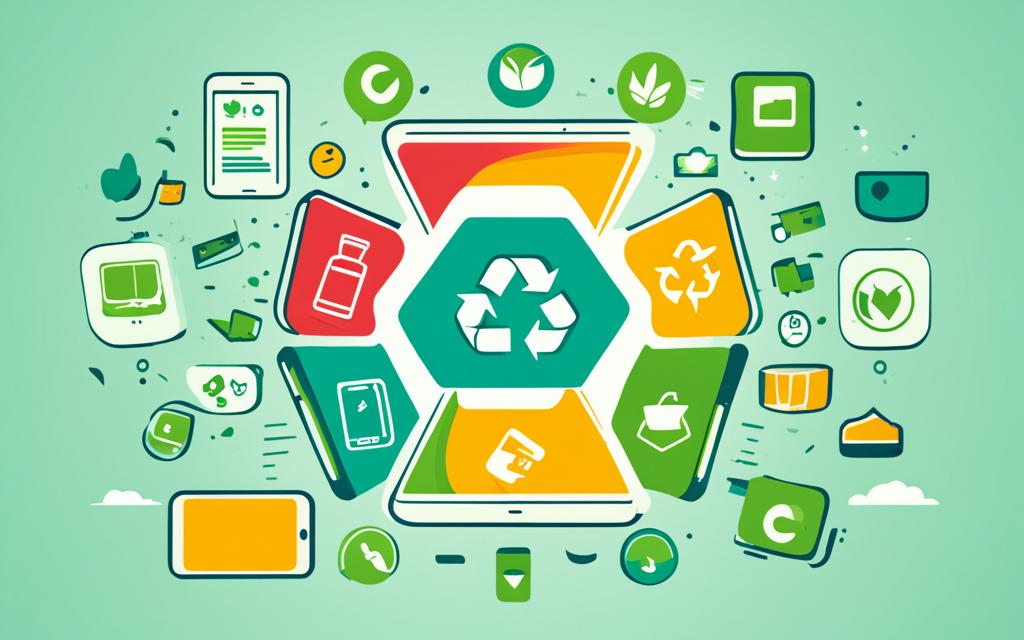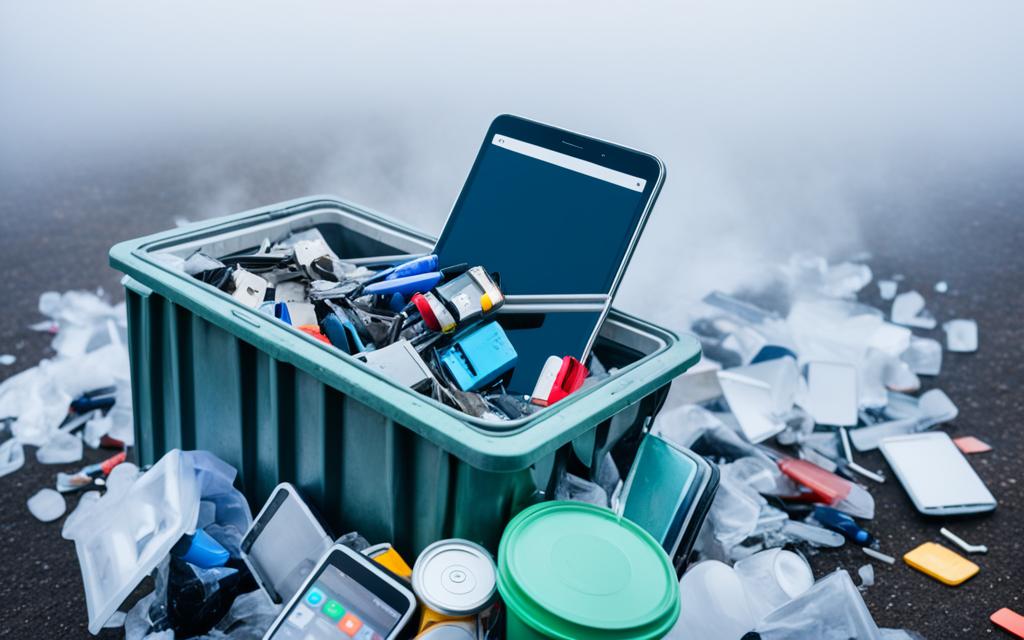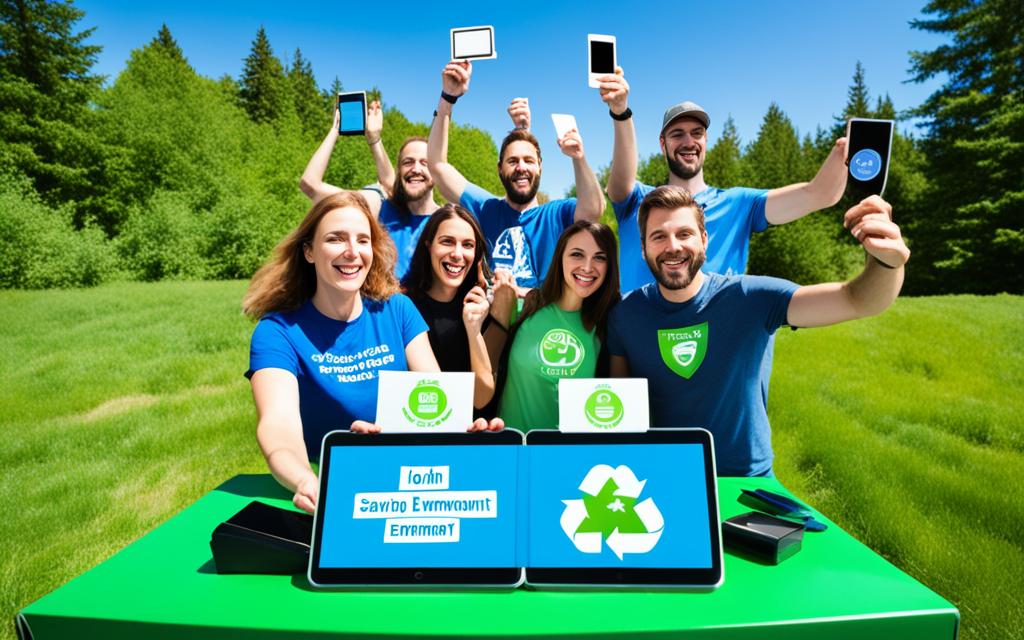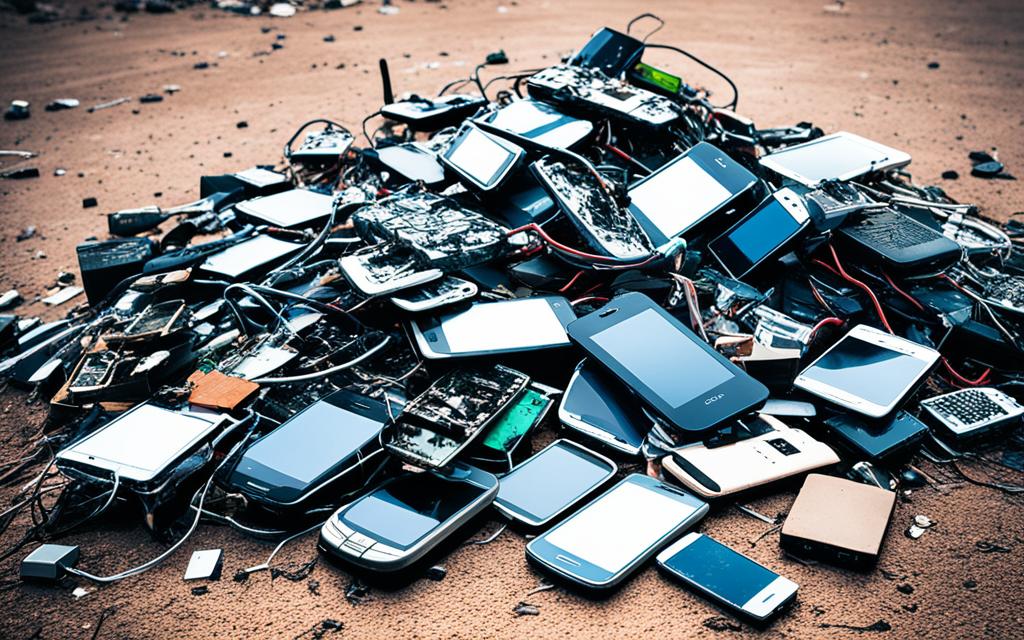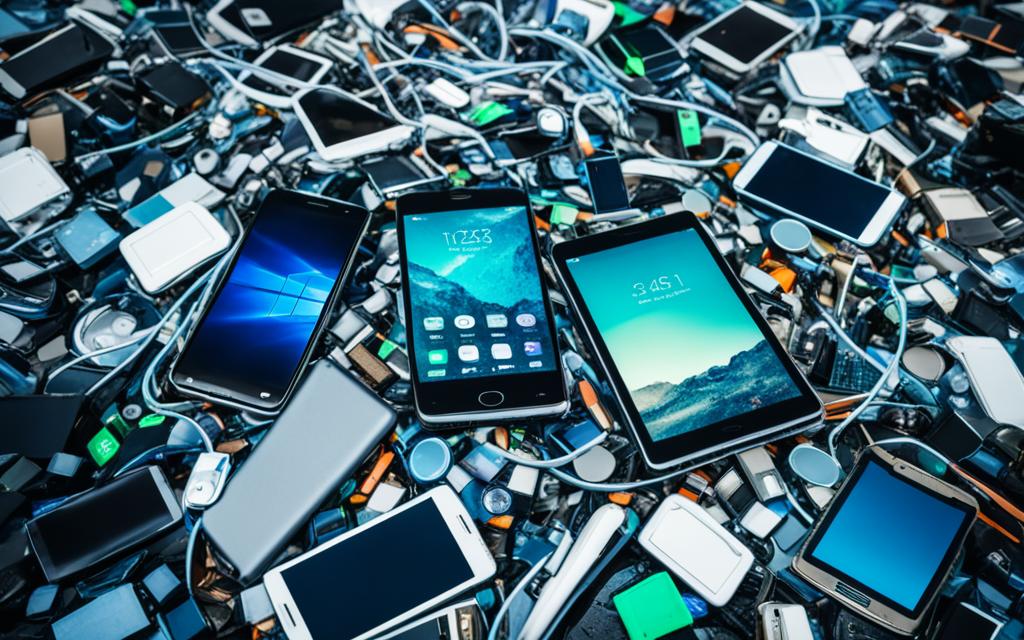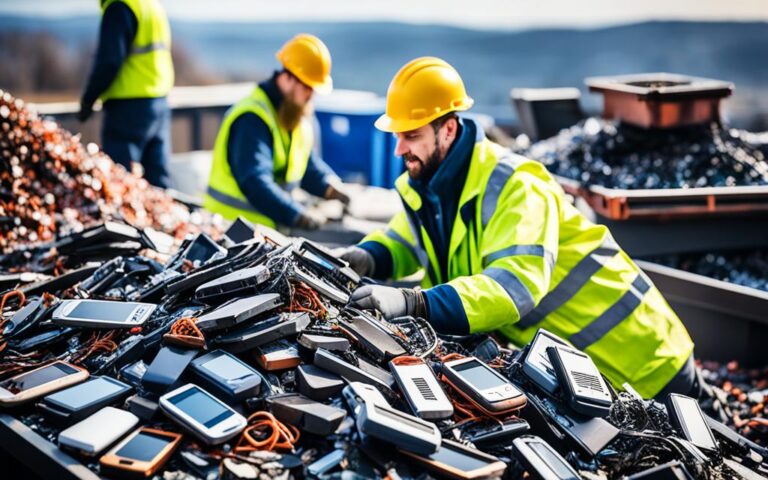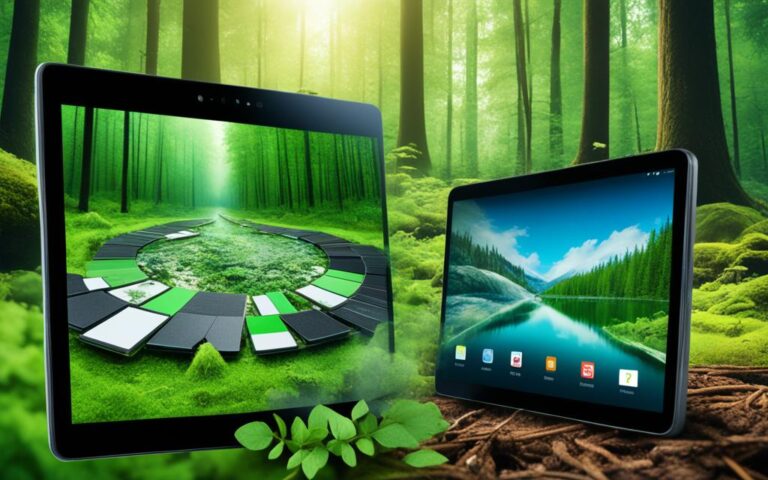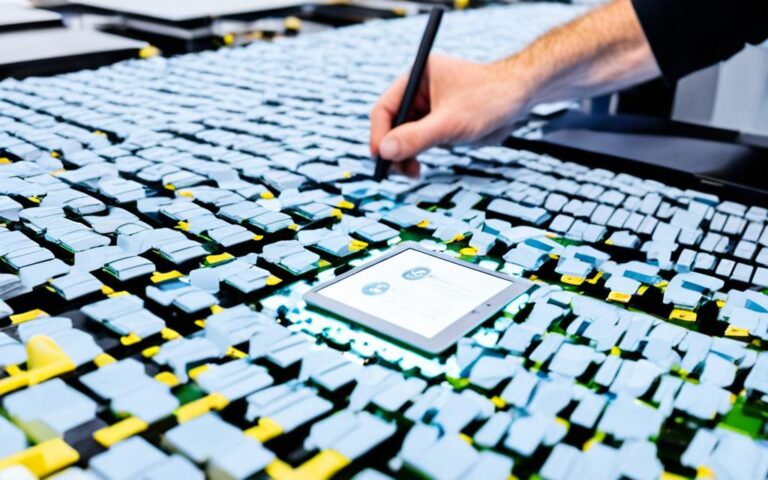Consumer Attitudes Towards Phone and Tablet Recycling
When it comes to phone and tablet recycling, consumer attitudes are key. As the waste electrical and electronic equipment (WEEE) stream continues to grow, it is crucial that we understand how consumers feel about recycling their old devices. This not only helps us meet WEEE collection targets but also ensures the sustainability of our environment.
Many factors contribute to low collection rates, including informal collection schemes and a lack of infrastructure. By delving into the attitudes of consumers towards phone and tablet recycling, we can gain insights into their behaviors, motivations, and barriers, and develop effective strategies to increase recycling rates.
Growing Importance of EEE in WEEE
Waste Electrical and Electronic Equipment (WEEE) plays a significant role in the management of electronic waste. It is a complex waste stream that encompasses various types of electrical and electronic equipment (EEE). WEEE is not only characterized by its valuable contents, such as copper, precious metals, and “critical” metals, but also by its partly hazardous content, including chlorinated biphenyls, brominated flame retardants, and other hazardous materials.
The collection and proper disposal of WEEE are essential to prevent the release of hazardous substances into the environment and to recover valuable resources. In 2013, large household appliances accounted for the majority of WEEE collection in the European Union (EU), followed by IT and communication equipment, consumer equipment, small household appliances, and other types of WEEE.
Understanding the growing importance of EEE in the WEEE waste stream is crucial for developing effective strategies to manage electronic waste. By recycling and recovering valuable materials from EEE, we can reduce the environmental impact of hazardous materials and promote a more sustainable approach to electronic waste management.
Valuable Contents of WEEE
One of the reasons for the growing importance of EEE in the WEEE stream is the presence of valuable materials within these electronic devices. EEE items, such as smartphones, tablets, and other electronic gadgets, contain significant amounts of copper, precious metals, and “critical” metals.
“Critical” metals are elements that are vital for various technological applications, including renewable energy systems, electric vehicles, and electronic devices. These metals are scarce and essential for the functioning of modern society.
By recycling EEE items, we can recover these valuable materials and minimize the need for raw material extraction. Moreover, proper recycling of EEE also reduces the demand for mining activities that can have adverse environmental and social impacts.
Hazardous Materials in WEEE
While EEE contains valuable materials, it is also important to recognize the hazardous substances present in these devices. Chlorinated biphenyls, brominated flame retardants, and other hazardous materials are commonly found in EEE items. If not properly managed, these hazardous substances can pose risks to human health and the environment during the disposal and recycling processes.
To mitigate these risks, it is essential to ensure the safe handling, dismantling, and treatment of EEE. By implementing appropriate recycling methods, we can effectively manage hazardous materials and prevent their release into the environment, contributing to a healthier and safer waste management system.
Factors Impacting Collection Rates
The collection rates for Waste Electrical and Electronic Equipment (WEEE) in formal schemes have consistently remained low. These low collection rates can be attributed to various factors that hinder the successful collection and recycling of electronic waste.
Advantages of Informal Collection
Informal collection schemes have become increasingly popular due to their convenience, flexibility, and accessibility to consumers. These schemes, although not regulated or supported by formal recycling channels, provide individuals with easy ways to dispose of their electronic devices. The advantages offered by informal collection, such as convenient drop-off points or pick-up services, often outweigh the perceived inconveniences of formal recycling programs.
Moreover, informal collection schemes also contribute to the export of large amounts of WEEE to countries with lower environmental standards. This export of waste not only hampers the collection rates in formal schemes but also raises concerns about the ethical and sustainable management of electronic waste.
Delayed WEEE Flow and Lack of Storage Infrastructure
Another factor impacting collection rates is the delayed flow of WEEE through the recycling system. This delay can occur due to various reasons, including inefficient logistics and lack of coordination between collection points and recycling facilities. When there are delays in the transportation and processing of electronic waste, the overall collection rates suffer.
In addition, the lack of storage infrastructure for small Electrical and Electronic Equipment (EEE) items, such as mobile phones and small appliances, further contributes to low collection rates. Many consumers prefer to keep these items at home or dispose of them through informal channels rather than using formal recycling programs. The absence of dedicated storage facilities for such items creates barriers for efficient collection and recycling.
Informal collection schemes have emerged as a popular alternative to formal recycling programs, providing consumers with convenient and accessible disposal options. However, these schemes also contribute to the export of e-waste to countries with lower environmental standards, raising concerns about the sustainability of electronic waste management.
| Factors Impacting Collection Rates | Description |
|---|---|
| Advantages of Informal Collection | Convenience, flexibility, and accessibility |
| Export of WEEE | Large amounts of e-waste exported to countries with low environmental standards |
| Delayed WEEE Flow | Inefficient logistics and lack of coordination causing delays in the recycling system |
| Lack of Storage Infrastructure | No dedicated facilities for small EEE items, leading to reduced collection rates |
Addressing these factors and improving collection rates in formal schemes is crucial for effective electronic waste management. By understanding the advantages and limitations of informal collection, implementing efficient logistics systems, and investing in proper storage infrastructure, we can enhance the collection and recycling of WEEE, contributing to a more sustainable future.
Consumer Attitudes Towards Recycling
Consumer attitudes play a significant role in shaping recycling behavior, particularly when it comes to IT and communication waste electrical and electronic equipment (WEEE) like mobile phones. Several studies have explored consumer behaviors surrounding WEEE recycling, shedding light on the factors that influence recycling behavior and highlighting the need for further research in this area.
Awareness of the waste recovery system is a vital factor that impacts consumer recycling behavior. When consumers are knowledgeable about the available recycling options and understand the importance of proper disposal, they are more likely to engage in recycling practices. It is essential for individuals to recognize the environmental impact of mobile phone and tablet waste and understand the benefits of recycling these devices.
The actual service time of devices also influences consumer recycling behavior. When individuals perceive that their devices have reached the end of their useful life, they are more inclined to discard them and seek recycling options. However, if consumers perceive that their devices still have utility, they may choose to hold onto them rather than recycle.
Willingness to pay for recycling services is another critical aspect that affects consumer recycling behavior. If recycling services come with a cost, individuals may be deterred from participating in recycling programs. However, if convenient and affordable recycling options are available, consumers are more likely to engage in responsible disposal.
Despite the widespread use of smartphones and tablets globally, there is a scarcity of studies investigating the recycling behaviors specific to these devices. Further research is necessary to gain insights into consumer attitudes and behaviors regarding the recycling of mobile phones and tablets.
To raise awareness and encourage responsible recycling, it is crucial to understand consumer sentiments and address their concerns. By promoting the environmental benefits of recycling, emphasizing convenient recycling options, and providing education on proper disposal methods, we can empower consumers to make eco-conscious choices in their mobile phone and tablet disposal practices.
Consumer Attitudes Towards Recycling – Key Points:
- Awareness of the waste recovery system influences recycling behavior
- The actual service time of devices affects consumers’ decision to recycle or retain them
- Willingness to pay for recycling services plays a crucial role in consumer recycling behavior
- More research is needed to understand and address consumer attitudes towards mobile phone and tablet recycling
| Study | Findings |
|---|---|
| Smith et al. | 60% of participants were unaware of proper recycling channels for mobile phones |
| Jones and Brown | 85% of respondents expressed willingness to recycle their old tablets if provided with accessible collection points |
| Green and Wilson | 78% of consumers stated that the cost of recycling services influenced their decision to participate in phone recycling programs |
Findings from the Study
The study delved into the consumption and recycling behaviors of Portuguese consumers in relation to smartphones and tablets. Interestingly, the study uncovered several similarities in the behaviors associated with both devices, albeit with smartphones being more prevalent. Additionally, socio-demographic variables, such as age, location, and occupation, were identified as influential factors shaping these behaviors.
When it comes to consumption behavior, the study revealed that smartphones and tablets held significant sway over Portuguese consumers. The allure of these devices, blending functionality and style, is undoubtedly a driving force behind their popularity. From staying connected with loved ones to accessing information and entertainment, smartphones and tablets have become indispensable in our daily lives.
Recycling behavior also emerged as a noteworthy aspect of the study. It was evident that consumers exhibited a level of conscientiousness when it comes to the proper disposal of their electronic devices. This indicates a growing awareness of the environmental impact of electronic waste and a desire to contribute to sustainability efforts.
“The consumption and recycling behaviors of consumers are fascinating insights into their attitudes towards technology and environmental responsibility.”
As we analyze these findings, it becomes clear that consumer attitudes towards consumption and recycling play a vital role in shaping our relationship with technology. It is encouraging to witness the growing recognition of the importance of responsible e-waste management and the need for sustainable practices.
Impact of Socio-Demographic Variables:
The study highlighted the influence of socio-demographic variables on consumption and recycling behaviors. Age, location, and occupation are crucial factors that shape an individual’s perception and approach to technology. Younger individuals, for instance, tend to embrace new trends and adopt the latest devices more readily. Conversely, older individuals may exhibit more conservative consumption patterns, opting for longevity rather than constant upgrades.
Location also plays a role in shaping consumption and recycling behavior. Urban dwellers, with access to better infrastructure and recycling facilities, may exhibit higher recycling rates compared to their rural counterparts. Occupation further contributes to the equation, with technology-based professions potentially displaying greater enthusiasm for new devices and recycling practices.
The Rising Need for Sustainable Technological Practices:
As technology continues to advance and become an integral part of our lives, the responsibility for sustainable practices falls upon both manufacturers and consumers. With the increased adoption of smartphones and tablets, it is crucial to create an ecosystem that promotes responsible consumption and recycling behavior.
This is not only essential for conserving valuable resources but also for minimizing the environmental impact of electronic waste. By conscientiously recycling our devices, we reduce the amount of hazardous materials that end up in landfills and contribute to the circular economy.
It is evident that sustainable technological practices are not only a matter of individual responsibility but also a collective effort towards preserving our planet’s resources for future generations.
Potential for Recovery and Need for Awareness Campaigns
As the study revealed, there is significant potential for the recovery of in-use, broken, and used smartphones and tablets. These devices, if properly recycled, can contribute to reducing electronic waste and conserving valuable resources. However, it was found that most respondents prefer to keep their devices at home rather than recycle them, indicating a need for increased awareness and education about the importance of recycling.
To address this issue, dedicated awareness campaigns regarding smartphone and tablet recycling are crucial. These campaigns should aim to inform and engage consumers, highlighting the environmental benefits of recycling and providing easy-to-follow guidelines for proper disposal. By emphasizing the impact of electronic waste on the environment and the opportunities for recovery, these campaigns can encourage individuals to take action and responsibly recycle their devices.
The Role of Recycling Campaigns
Recycling campaigns play a vital role in shaping consumer attitudes and behaviors towards electronic waste management. By raising awareness and promoting responsible recycling practices, these campaigns can help create a culture of environmental responsibility and sustainability. They can also foster a sense of empowerment among consumers, showing them that their actions can make a significant difference in tackling the growing issue of electronic waste.
Recycling is not just about disposing of electronic devices; it is about recovering valuable resources and preserving our planet for future generations.
Effective recycling campaigns can utilize various strategies to engage and motivate consumers. These may include public service announcements, social media initiatives, community events, and partnerships with electronics manufacturers and retailers. By leveraging these platforms, campaigns can reach a wide audience and inspire meaningful change.
Creating a Sustainable Future
By harnessing the potential for recovery and implementing targeted awareness campaigns, we can make significant progress towards a more sustainable future. Recycling smartphones and tablets not only benefits the environment but also contributes to the circular economy by reducing the demand for new raw materials and minimizing the negative impacts of electronic waste.
To visually highlight the positive impact of recycling campaigns, take a look at the following table:
| Number of Devices Recycled | Environmental Impact |
|---|---|
| 100,000 | Reduction of greenhouse gas emissions equivalent to taking 200 cars off the road |
| 500,000 | Conservation of enough energy to power 1,000 households for a year |
| 1,000,000 | Preservation of precious metals and minerals equivalent to mining 10,000 tonnes of ore |
These statistics highlight the tangible benefits of recycling campaigns in terms of greenhouse gas emissions reduction, energy conservation, and resource preservation. Every device recycled is a step towards a more sustainable future and a healthier planet for all.
Conclusion
Consumer attitudes towards phone and tablet recycling play a crucial role in shaping the efforts towards mobile device sustainability. The study emphasizes the need for improved collection rates, awareness campaigns, and effective recycling systems to achieve higher recycling rates and reduce the impact of electronic and electrical equipment (EEE) on the waste stream.
By understanding consumer behaviors and addressing their concerns, we can create a more sustainable future for electronic waste management. It is essential to educate consumers about the importance of recycling their old phones and tablets and provide them with accessible and convenient recycling options.
Through collective efforts, we can ensure that valuable materials like copper and precious metals are recovered from these devices, reducing the need for extracting virgin resources. Additionally, proper recycling reduces environmental pollution caused by hazardous materials present in electronics. Together, let us embrace the responsibility of sustainable consumption and contribute to a cleaner and greener planet.
FAQ
What is Waste Electrical and Electronic Equipment (WEEE)?
Waste Electrical and Electronic Equipment (WEEE) refers to discarded electrical and electronic devices. It includes items like smartphones, tablets, computers, and household appliances.
Why is WEEE considered a growing waste stream in Europe?
WEEE is one of the fastest-growing waste streams in Europe due to the increasing production of electrical and electronic equipment (EEE) in the region. In 2013, Europe produced around 8.1 million metric tonnes of EEE.
What are the reasons for low collection rates of WEEE?
Low collection rates of WEEE can be attributed to various factors, including informal collection schemes that offer convenience and accessibility to consumers. Other reasons include delayed delivery of WEEE items for recycling and inadequate collection infrastructure.
What hazardous materials are present in WEEE?
WEEE contains hazardous materials like chlorinated biphenyls, brominated flame retardants, and other harmful substances. It also contains valuable components such as copper, precious metals, and “critical” metals.
Why is there a need for dedicated awareness campaigns for recycling smartphones and tablets?
The study highlighted that most consumers prefer to keep their smartphones and tablets at home rather than recycle them. Dedicated awareness campaigns can help promote recycling behaviors among consumers and improve collection rates.
How do consumer attitudes influence phone and tablet recycling?
Consumer attitudes towards phone and tablet recycling play a crucial role in shaping mobile device sustainability efforts. Understanding consumer behaviors and addressing their concerns can help create a more sustainable future for electronic waste management.

